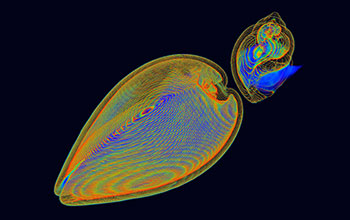Multimedia Gallery
"Self Defense"
"Self Defense," by Kai-hung Fung, Pamela Youde Nethersole Eastern Hospital, Hong Kong.
This is no shell game but a matter of life or death. The clam (left) can snap its bivalve shell shut at the first sign of a threat. The whelk (right) has evolved another strategy: The spiral shell provides a series of barricades to potential invaders. This dramatic example of two different evolutionary strategies for self-defense caught the eye of radiologist Kai-hung Fung.
To create the image, Fung used a CT (computed tomography) scanner to visualize thin slices of the whelk and clam and then rendered their contours in rainbow colors to highlight their complex structures. Creating such images involves balancing "two sides of a coin," he says. "One side is factual information, while the other side is artistic."
This image won honorable mention in the photography category of the 2012 Visualization Challenge, now called the Vizzies, a long-running, annual competition co-sponsored by the National Science Foundation (NSF) and Popular Science magazine. [The competition was formerly named the International Science & Engineering Visualization Challenge (SciVis) and was previously co-sponsored with AAAS' journal Science.] The competition aims to recognize some of the most beautiful visualizations from the worlds of science and engineering and awards prizes in five categories: photography, video, illustration, posters & graphics and interactives.
To learn more about the competition and view all the winning entries, past and present, see the NSF Special Report The VIZZIES: Visualization Challenge. (Date of Image: June 2012)
Credit: Kai-hung Fung, Pamela Youde Nethersole Eastern Hospital, Hong Kong
Images and other media in the National Science Foundation Multimedia Gallery are available for use in print and electronic material by NSF employees, members of the media, university staff, teachers and the general public. All media in the gallery are intended for personal, educational and nonprofit/non-commercial use only.
Images credited to the National Science Foundation, a federal agency, are in the public domain. The images were created by employees of the United States Government as part of their official duties or prepared by contractors as "works for hire" for NSF. You may freely use NSF-credited images and, at your discretion, credit NSF with a "Courtesy: National Science Foundation" notation.
Additional information about general usage can be found in Conditions.
Also Available:
Download the high-resolution JPG version of the image. (4.3 MB)
Use your mouse to right-click (Mac users may need to Ctrl-click) the link above and choose the option that will save the file or target to your computer.

